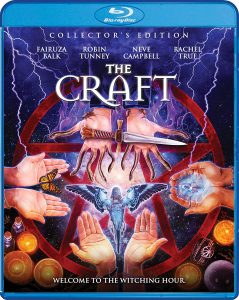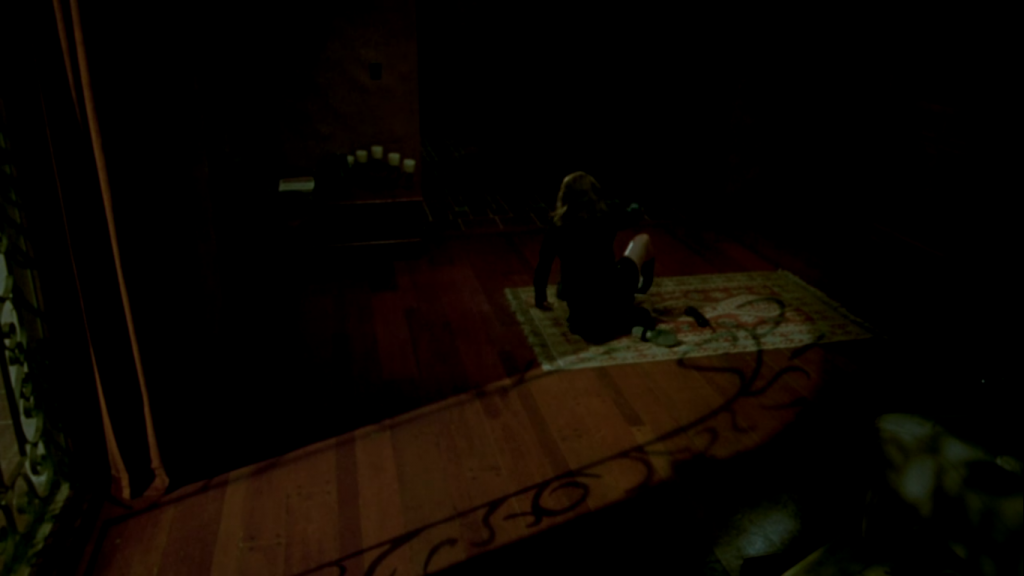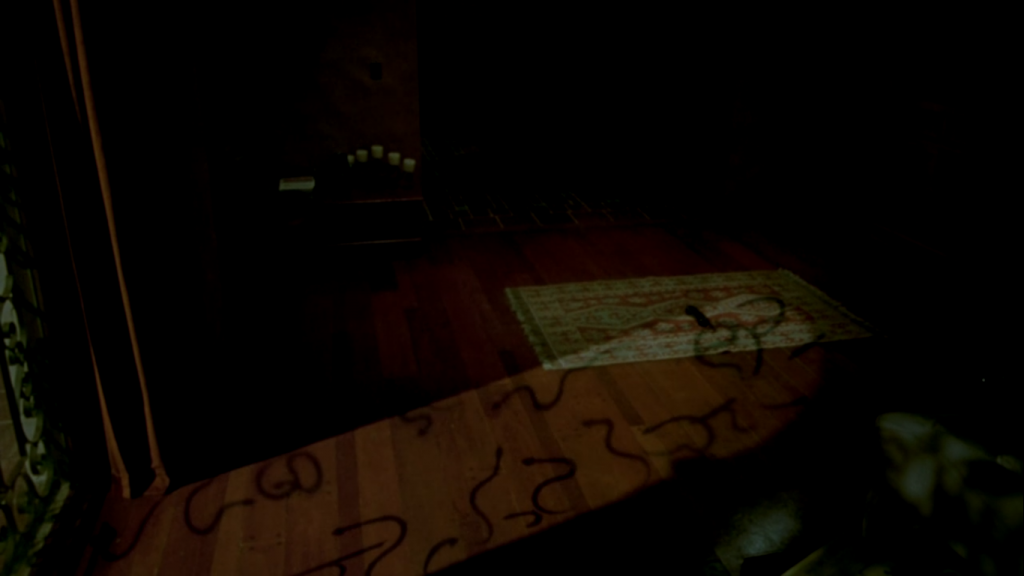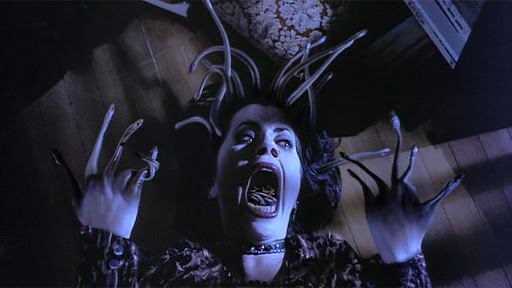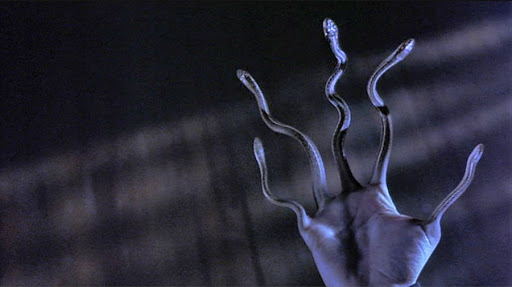‘Big animals steal from little ones’ – Bonnie Harper (Neve Campbell)
The Craft (1996) epitomises the intensity of teenage female friendships, and how quickly and violently these bonds can be broken. This kind of teenage sisterhood and its potential for moments of both great beauty and disaster is played out through the use of animals in this film. Brought together by chance, three girls rumoured to be witches befriend Sarah Bailey (Robin Tunney), the troubled new girl at school. In some capacity, the four are likened to animals, which hints towards an emerging power struggle between Sarah and the coven’s unofficial leader, Nancy Downs (Fairuza Balk), and they are characterised as a lovebird and a snake respectively. Their early forays into witchcraft are benign, as they ask a deity called Manon to bestow upon them abilities that will afford them an easier life at school. These gifts ultimately yield terrifying consequences, as Nancy’s desire to remain at the top of the proverbial food chain increases, along with Bonnie Harper (Neve Campbell) and Rochelle Zimmermann’s (Rachel True) parasitic desire to belong.
The film fits well within the teenage horror genre, as it puts a supernatural spin on the most important aspects of a typical teenage girl’s life – in particular, the comfort of female friendship. Animals are a key component in creating the horrific aspects of the film, and the sheer number of animals used at key points maximises the revulsion and fear that the horror genre requires. One example of this is the film’s preoccupation with snakes, with around 2000 snakes used at the film’s climax, taking advantage of both the conventional horror genre and the natural human sense of ophiophobia. Fleming also ensures that the film is rooted firmly in the horror genre by using animals to foreshadow later events. Within the first few minutes Sarah is confronted by a vagrant with a snake, an abrupt but relatively harmless encounter when compared with the final battle between Sarah and Nancy, in which Nancy unleashes a plague of snakes, insects and rats upon Sarah. Metamorphosis is at the heart of The Craft, mapping the transformation of the girls’ friendship throughout the film. Contrary to the conventions of the horror genre, this animal-like metamorphosis is not always used as a sign of foreboding. Bonnie, for example, is figured as a butterfly, symbolising her individual physical transformation from something considered ugly into something conventionally beautiful.
The girls’ journey from being known as a disconnected group of outcasts to becoming a powerful coven is consolidated once they perform their first ritual as a group, referring to each other as sisters rather than merely friends. Following this ritual, the girls become surrounded by monarch butterflies in a moment of harmony (Fig. 1). Mystical music and gentle chimes play in the background, overlaid with the sound of birds tweeting as the girls laugh in amazement that their wishes have been answered by Manon. The scene is rich in colour, flooded with golden sunshine. The overwhelming warmth of colour in this scene is almost uncharacteristic of a horror film, emphasising the strength of the girls’ friendship and its potential for good.
This scene also subverts the idea that only stereotypically fearsome animals should play a role in horror. As the butterflies descend and spread from the left of the screen to the right, we get a sense of forward progression, adding to the sense of hopefulness that this scene puts forth. While butterflies fly around the girls, we see two butterflies land on Bonnie, who has scars that cover her entire body, and is previously seen hiding herself under several layers of clothing. In this scene however, she lets her cardigan hang loosely off her shoulder, a nod to the safety she feels among her sisters. She is situated in the shade of the trees, a place where a monarch caterpillar would seek out to build its cocoon, symbolising the beginning of her transformation. Monarch butterflies in particular are symbols of transformation, from an unremarkable caterpillar into a vibrant butterfly. By landing on Bonnie, the butterfly serves to foreshadow her upcoming transformation as her scars begin to fade. This is not without its complications however, as only her external appearance changes, which ultimately breeds an overwhelming sense of vanity within her, emphasising the fine line between self-love and self-obsession and hinting toward the precarious balance of the girls’ friendship.
The film takes advantage of the natural human sense of revulsion and uses this to exacerbate the horror of the film. Although we are presented with an overwhelming amount of animals that have a natural ability to instil fear in a viewer, including over 10,000 snakes in the entire production, the scariest creature stalking through Sarah’s home at the film’s climax is Nancy. Noel Carroll notes that the true horror of the horrific creature cannot be seen, and therefore it is necessary to surround the horrific being, in this case Nancy, with objects that we already perceive to be objects of disgust and/or phobia [1], such as the snakes, spiders, maggots, rats and scorpions. For Sarah, these animals are made even more terrifying due to the fact that she previously confided in Nancy that, prior to her suicide attempt, she experienced relentless hallucinations of snakes and insects. In many ways, Nancy can be likened to a snake – a symbol of healing and renewal, she initially offers a sense of belonging to Sarah. Like the monarch butterfly, snakes are also a powerful symbol of personal growth and development, however Nancy fails to engage in any personal growth, choosing instead to usurp the powers of Manon and, after designating Sarah as her rival, attempting to kill her.
Another key scene of metamorphosis takes place just prior to Sarah and Nancy’s final battle, in which Nancy uses a glamour spell to force Sarah to see snakes, as well as rats, maggots, cockroaches and spiders all over her home. The moonlight shines through the ornate pattern of the doorframe, casting curved shadows on the floor (Fig. 4). As Sarah leaves, the shadow of the decorative features on the doorway transform into snakes, slithering along the ground (Fig. 5). This visual depiction of Sarah’s domestic sphere being infiltrated by such a malevolent presence emphasises the power that Nancy possesses over her. She attempts to leave her house, but a sea of snakes block her path (Fig. 3), cutting short any attempts to escape, while forcing her to see her home as a place of terror. Additionally, a wide shot of the path outside her home makes Sarah appear incredibly small and entirely alone in comparison to the vast amount of snakes in her way. The non-diegetic drone of string instruments, coupled with the slithering and squeaking of the animals is interrupted only by Sarah’s screams of terror, highlighting the immense imbalance of power between her and Nancy, as well as Nancy’s manipulation of Sarah’s fears.
However, as a glamour, this spell is only superficial, suggesting that Nancy’s powers are impressive, but not dangerous. She has the power to create such terrifying images, but they are just that – images. Additionally, the majority of the snakes in this scene are harmless, like the Burmese python on the stairs, the garter snakes in the garden, and the rat snake in the bathroom. While Nancy may seem like a powerful witch, her powers are only superficial. Once Sarah understands this fact, she uses Nancy’s glamour spells against her, conjuring her own terrifying image (Fig 6). For the first time, we see Nancy looking scared, as if Sarah’s exploitation of Nancy’s glamour spells has destroyed Nancy’s illusion of power.
Nancy’s relentless struggle for power without a sense of personal growth ultimately brings about her downfall, and her power to conjure snakes is used against her by Sarah. Her appearance is reminiscent of Medusa as snakes protrude from her head and her fingers morph into snakes, in this instance however, Nancy is the one who appears paralysed by her own ghastly image. Her mouth fills with maggots (Fig. 6), signifying that, in contrast to Sarah, whose powers have increased, Nancy has failed to undergo any journey of personal growth, and is consequently decaying on the inside because of how she has abused her powers.
In this scene, Nancy epitomises the horrific effects of the death of the girls’ friendship. Her skin takes on a blue, corpse-like colour as she stares in horror at her hands (Fig. 7). As her fingers are transfigured into snakes, she is powerless to do anything but watch herself transform, emphasising that even though she is an incredibly powerful witch, she still has the potential to be terrified by such creatures the moment she loses control of them.
The film’s message is clear – all characters have the capacity for good and evil. Because of Nancy, Sarah is both loved and hated. This exemplifies the duality that is found in snake symbolism – snakes can represent rebirth, as Nancy helps Sarah through her symbolic rebirth following her suicide attempt, into the coven, a place where she feels as though she belongs. This is complicated by Nancy’s obsession with power, turning her into a destructive force and aligning her more closely with Christian beliefs of snakes being a symbol of evil.
Animals are an integral part of The Craft, in conveying both the beautiful and the horrific potential of adolescent friendships. The two main character motifs in this film, butterflies and snakes, are used to highlight the fact that creatures we interpret to be beautiful, we characterise as ‘safe’ and ‘good’, and creatures that we interpret to be ugly or horrific, we characterise as ‘evil’. By characterising Bonnie and Nancy as a butterfly and a snake, we see the potential for both evil and good, which is played out through the arc of the girls’ friendship, from peaceful sisterhood to absolute destruction. As the kindly occult shop-owner Lirio Santana (Assumpta Serna) states ‘True magic is neither black, nor white. It’s both because nature is both. Loving and cruel, all at the same time’. Her statement suggests that there is initially something both magic and natural about the girls’ friendship – that their relationship must maintain a balance. The imbalance of their personalities, represented by a butterfly, a clownfish, a lovebird and a snake suggest that at best, their friendship is finite and at worst, it is deadly.
References:
[1] Noel Carroll, The Philosophy Of Horror Or, Paradoxes Of The Heart (Taylor & Francis, 2003) p51.
Bibliography:
Carroll, Noel, The Philosophy Of Horror Or, Paradoxes Of The Heart (Taylor & Francis, 2003)
Media:
The Craft, dir., Andrew Fleming, (Columbia Pictures: 1996)
Further Reading:
Briefel, A. “Devil In The Details: The Uncanny History Of The Witch (2015)”, Film & History, Cleveland OK, 49 (2021), 4-20 <https://search-proquest-com.sheffield.idm.oclc.org/scholarly-journals/devil-details-uncanny-history-witch-2015/docview/2280399460/se-2?accountid=13828> [accessed 18th January 2021]
Chandler, E. “‘Loving And Cruel, All At The Same Time’: Girlhood Identity In The Craft”, Girlhood Studies, 9 (2016), 109-125 <https://doi.org/10.3167/ghs.2016.090213> [accessed 18th January 2021]
Schimmelpfennig, A. (2013) ‘Chaos Reigns – Women As Witches In Contemporary Film And The Fairy Tales Of The Brothers Grimm’, Gender Forum, 4-18 <https://search-proquest-com.sheffield.idm.oclc.org/docview/1444595138?pq-origsite=summon&https://search.proquest.com/pq1lit> [accessed 20th January 2021]
